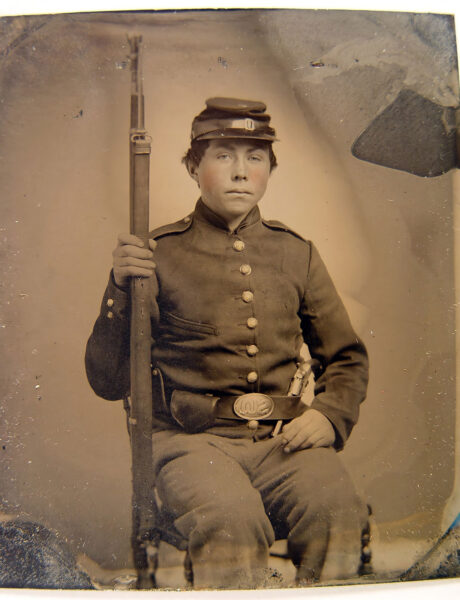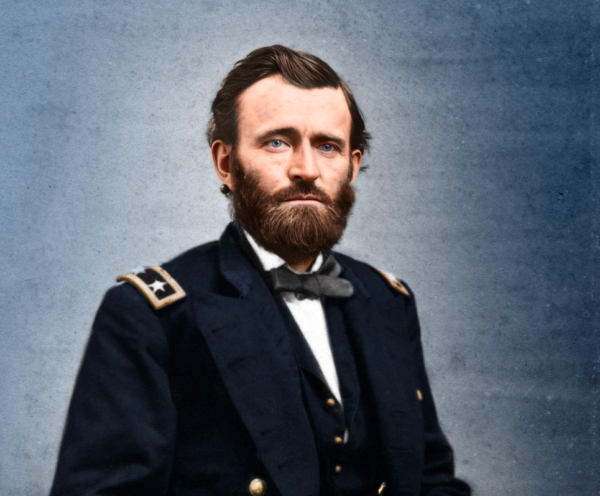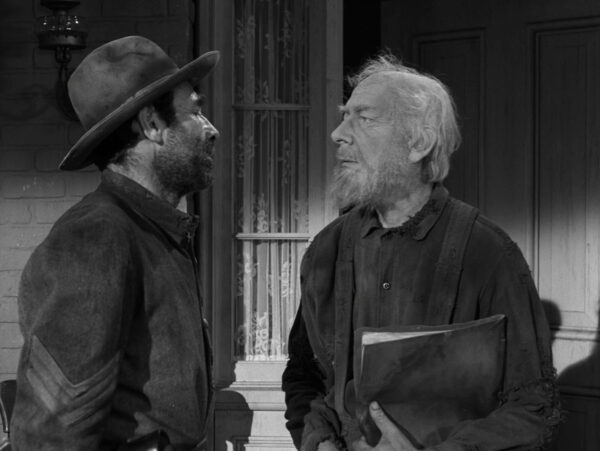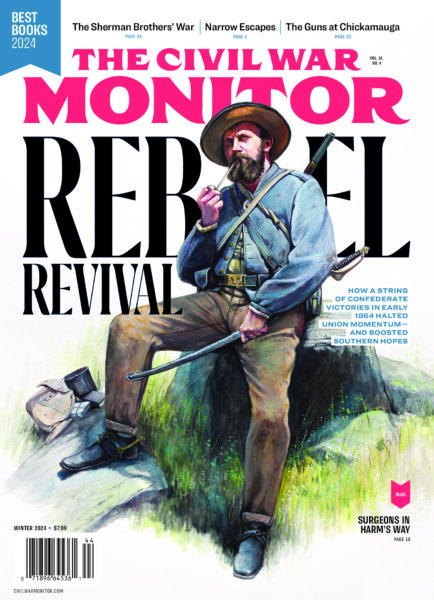Boy Soldiers
I just finished my first reading of your Summer 2024 issue. I always look forward to the book section, insights into the latest historical research, and original perspectives such as the Spring 2024 issue’s feature story on generals’ wives, “Partners in War.”
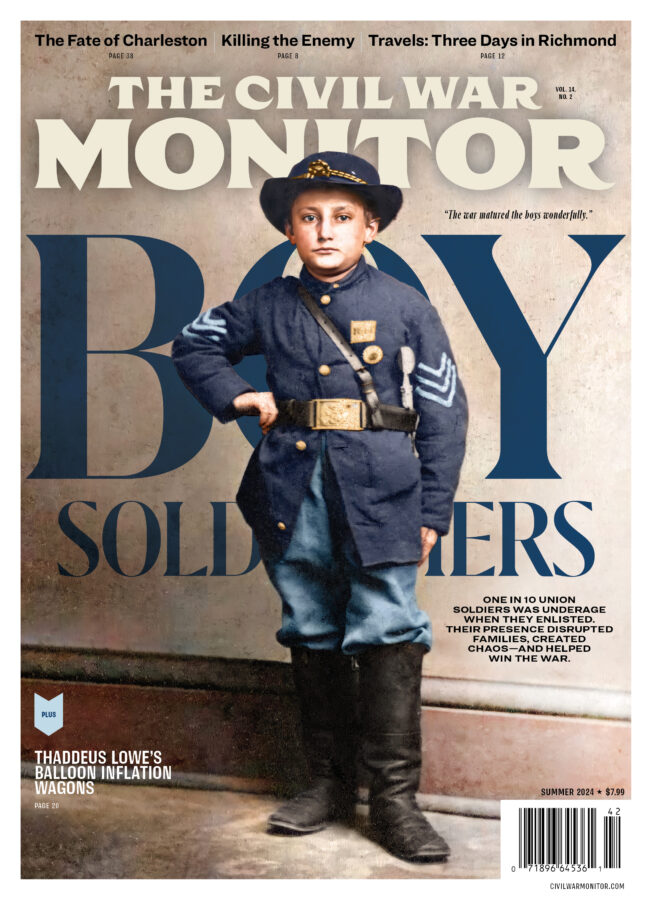
This issue did not disappoint. Now retired for many years from my time in the Marines and career in the classroom, I volunteer at Vale Cemetery in Schenectady, New York, home of two Civil War Medal of Honor recipients, as well as many members of the 134th New York Infantry. Their contribution to the Battle of Gettysburg was not insignificant, and many Civil War-era headstones stand as proud testimony to their devotion to duty. It is an honor to help maintain their final resting places. I encourage other retirees to see how they can help keep history alive in their communities.
Regarding the Summer issue’s lead feature, “Boy Soldiers”: As the Confederacy found itself facing defeat toward the end of the war, did its leaders deploy even younger recruits, similar to German child-soldiers seen in pictures surrendering to advancing Allies near the end of World War II? Did late wartime demands increase the contributions of southern women and slaves to the war effort?
Jeff Austin
Schenectady, New York
Ed. Thanks for your feedback, Jeff. We forwarded your questions prompted by “Boy Soldiers” to Frances M. Clarke, who co-authored the article with Rebecca Jo Plant. She responds: “It’s true that the Confederacy was in desperate straits by the war’s final year, and they were seeking to enlist as many men as possible—even those with ailments or conditions that would once have precluded their service. But Confederate leaders were also largely hostile to lowering the age limit, fearful of destroying a generation of future male leaders. Even when they changed the rules in February 1864 to conscript 17-year-olds, they only allowed this cohort to serve in home guard or junior reserve units, which generally meant home front rather than frontline duties. On the other hand, desperation meant that they were also relying on these units in new ways at war’s end—even to the point of sending some of them out of state and into the fighting. The situation was mixed, in other words, with lots of boys volunteering to serve but Confederate elites also trying to keep them out of the struggle. As for mobilizing white women, free black southerners, and the enslaved, this is not something we write about, but other historians have shown that hostility toward the Confederacy from this section of the population seriously undermined its war effort.”
* * *
I have researched the boys and youth of the Civil War for many years, using the material to teach the Civil War to my students from their peers’ point of view. Having just released my own work sharing many of their stories and images, I find that Frances M. Clarke and Rebecca Jo Plant’s feature article “Boy Soldiers” takes a whole new direction than anything I have found in my research. Their point of view is most interesting and informative. While I have focused my research on who the boy soldiers were, Clarke and Plant focus on the social effects their presence had on a broad spectrum, from familial to political. Praise to them for a job well done regarding a large body of veterans generally forgotten.
Joel A. Moore
Narvon, Pennsylvania
About That Photo

I would like to know why some Civil War photos have been flopped horizontally, producing an image that is not the way we would see the person, but rather how that person would see themselves in a mirror. In the “Boy Soldiers” article in the Summer 2024 issue, page 37 includes an image [shown at right] of an unidentified young soldier in such a situation. I realize that tintypes printed direct to plate and so have no negative to flop one way then the other. So what is correct, reproducing the incorrect image, or fixing it?
Paul Mitchell
Via Facebook
Ed. Thanks for your message, Paul. We reached out to Ron Coddington, Civil War photography expert and publisher of Military Images magazine, for an answer to your question. He writes: “As Paul notes, tintypes are not produced from a negative, resulting in a laterally reversed image. The same is true for ambrotypes and daguerreotypes. Though a fix was available for cameras, it was not widely adopted. These photos are mirror images of sitters, which is considered by some historians as personal and intimate—and desirable. Images of citizens in reverse are less noticeable because civilian clothing is generally the same on either side, except for button holes and other small details. But in a photo of a soldier dressed in uniform, reversed insignia on caps and buckles was very visible and distracting. Some soldiers, like the young man in the image you reference, compensated for the effects of the lateral reverse by turning their U.S. belt buckles upside down to put the U on the left and the S on the right. Then as now, we show the images as they were created because this is how the Civil War generation saw them.”
Observatory
Kudos to Professor Matthew Hulbert on his two most recent “Observatory” columns in The Civil War Monitor: “The Centennial & The Twilight Zone” [Vol. 14, No. 1] and “Plotting Journey to Shiloh” [Vol. 14, No. 2]. Both articles were fun and interesting. They were also good reminders of the importance of understanding the historical context in which the stories occurred as well as the historical context in which they are interpreted.
Brian J. Steenbergen
Grand Rapids, Michigan
* * *
Many thanks for Matthew Christopher Hulbert’s “Observatory” essay in your Summer 2024 issue on the long-forgotten film Journey to Shiloh. As one of the tens of Americans who watched its television premier, it has long fascinated me. Ten year-old me in Virginia had no idea what to do with an anti-Confederate and antiwar Civil War movie, not to mention one in which the battlefield of Shiloh looked exactly like The Virginian’s Shiloh Ranch, i.e., a backlot in California. Hulbert is right to observe that it is not a great movie by any means. Yet in some ways, it really did eerily anticipate where Civil War history was about to go in the post-Vietnam era. Plus, how can you go wrong with a cast that includes James Caan, Harrison Ford, Jan-Michael Vincent, and Michael “Blue Boy” Burns from Dragnet?
Ken Noe
Draughon Professor of Southern History Emeritus, Auburn University
Via email
* * *
I never saw the movie Journey to Shiloh, but I spent six hours riding and walking the Shiloh battlefield last October. I had it pretty much to myself: Bloody Pond, the Confederate burial trenches, Ulysses S. Grant’s perch under the oak tree, the Hornet’s Nest. Having served two years in the U.S. Army (1970–1972), the line from the old song comes back to me: “War. What is it good for? Absolutely nothing.”
Rick Schulze
Omaha, Nebraska
Keep It Going
With the demise of Civil War Times, America’s Civil War, Sports Illustrated, Time, Newsweek, and limited content in most daily newspapers, yours is now the only print material I receive. I hope you are able to continue with your quality content and keep fighting against the death of print media. I’m not a Luddite, though. I just scanned the QR code in your Summer 2024 issue to receive your e-newsletter, The Gazette, online.
Dave Reilly
Fairport, New York
* * *
Thank God you are still here! With the recent demise of the History-Net magazines (Civil War Times, America’s Civil War, and others), you are all we have left. Thanks for putting out such a great magazine!
Mike Bell
Via email
Ed. Thanks for your notes, Dave and Mike. While it’s true that long-running publications like Civil War Times, America’s Civil War, and Newsweek have halted their print editions, I believe Sports Illustrated and Time are still in print, though perhaps less frequently. No need to worry about our print edition—it’s the core of what we do, and thanks to the support we receive from you and our other readers, it isn’t going anywhere. And, Dave, we’re glad to hear you signed up for our recently redesigned e-newsletter and hope you enjoy it! Anyone who’s interested should visit civilwarmonitor.com/newsletter. Signing up is free, and you can cancel at any time.
* * *
I have been subscribing to various Civil War magazines for over 50 years and, without question, your Monitor is the absolute best of them all! I am 87. This should convince you how serious I am about this statement! Best wishes for continued success and longevity!
Santo Fruscione
Encinitas, California
Letters to the Editor
Email us at [email protected] or write to The Civil War Monitor, P.O. Box 3041, Margate, N.J., 08402

